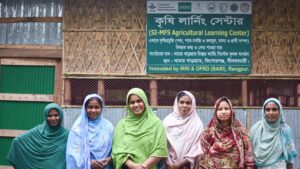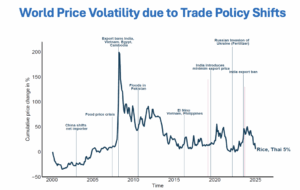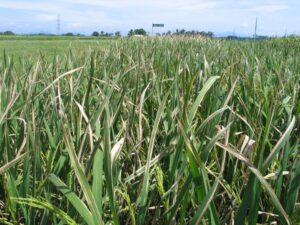Before scientists ever started crossing different rice plants, farmers had inadvertently been at it for centuries.
By the mid- 1800s, scientists were catching up, with Gregor Mendel’s research on inheritance and genetics paving the way for more advanced approaches to plant breeding into the 1900s.
These scientific discoveries couldn’t have been timed better. By the middle of the 20th century, fear of famine loomed when population growth seemed to have outstripped food production. Rice and wheat— two of the most important food crops in the developing world—benefited from international efforts to improve their productivity using a science-based breeding approach.
The pivotal “semi-dwarf”
IRRI’s hand in helping the rice-eating world through breeding better varieties of rice began shortly after the Ford and Rockefeller Foundations established the Institute with the help of the Philippine government in 1960. IRRI scientists sought to replicate in rice what had been done in wheat in Mexico, and successfully bred IR-8—a semi-dwarf variety that journalists dubbed “miracle rice” because it could produce twice the amount of rice grains that tall varieties produced. IR-8 has been credited with averting a humanitarian crisis that would have plunged the world’s poor into abject hunger (see Breeding history).
Since then, more than 900 IRRI varieties have been released in 78 countries, across five continents. Some of these were bred to be resistant to insects or diseases, and they can withstand poor soils. Two popular breeding lines, IR-64, released in 1985, and IR-72, released in 1988, have both high yield and good grain quality.
“Fifty years ago, it was a different scenario in terms of tools available to create better rice varieties,” said IRRI’s head of plant breeding, Dr. Eero C. Nissilä. “Today, we have modern breeding tools that help us do the work in less time.”
IRRI breeding was there
The progression of new rice varieties has reflected the challenges that farmers have faced over the years.
In the late 2000s, after decades of tracking down the gene that provides tolerance of flooding in rice, and after infusing this gene into popular varieties, IRRI released its flood-tolerant line.
Today, millions of hectares of rich rice farmlands in the delta regions of Asia have benefited from “scuba” rice—the rice that can withstand more than 2 weeks of total submergence.
An independent study of Indonesia, Vietnam, and the Philippines by the Australian Centre for International Agricultural Research showed that IRRI’s breeding program has helped increase rice yield up to 13%, giving these countries an extra $1.46 billion worth of rice each year.
What makes IRRI breeding exciting?
Today, IRRI scientists are working on rice that responds to specific needs of farmers in a particular region or ecology. An example is rice that can survive under stagnant water. This is a problem in rice-growing areas near delta regions such as those in Vietnam (see Appeasing “nine dragons” enraged by climate change).
Another example is rice that is tolerant of salinity. Salt-tolerant varieties have already been released in the Philippines and Bangladesh.
“Work is also underway to create “2-in-1 rice”—rice with combined tolerance of flood and salinity,” said Dr. Glenn Gregorio, deputy head of IRRI plant breeding. “The goal is not only to confer tolerance of flood and salt in popular varieties but also to make sure that they have good eating quality.”
Trends in farmers’ practices, observed in decades of household data gathered across Asia, are also finding their way into IRRI’s breeding agenda. An example is the increasing practice of direct seeding.
“Irrigated rice is an input-intensive undertaking as farmers have to pay laborers to transplant rice,” said Dr. Nissilä. “Farmers thus resort to direct seeding—a trend that has been observed in farmers’ fields. Once again, IRRI plant breeders see an opportunity to help. IRRI is now developing rice that germinates in anaerobic conditions, and we have been making good progress in this.”
To facilitate the spread of these improved rice types in areas that need them, IRRI is also creating breeding research hubs in South Asia as well as East and Southern Africa, so that upcoming lines can be tested in regional conditions. These hubs are facilities where IRRI breeding lines are evaluated in conditions unique to the region, in collaboration with national partners.
Also, to facilitate the efforts in breeding to respond to farmers’ needs, IRRI is creating product profiles for rice, per various rice ecologies, regions, and consumer needs.
“Rice is very cultural, and quality— not just yield—is also a major consideration in different rice preferences,” said Dr. Nissilä. “These product profiles will also help enhance our precision breeding, putting more value in our resources and efforts.”
IR100,000
Last 29 November, IRRI celebrated its 100,000th cross. But, what’s so special about the 100,000th cross? “It tells us how much we’ve gone through in our commitment to feed the world,” mused Dr. Gregorio. “More importantly, we hope that, by highlighting such a milestone, we renew enthusiasm toward plant breeding and the fact that it has benefited so many people globally.”
In breeding jargon, the 100,000th cross was between IRRI 151 (NSICRc214), a high-yielding popular variety with good grain quality, and IR09M105, a high-micronutrient rice variety.
“We hope to be able to get the best traits from both parents and create a variety that provides what farmers really need: more grain, with good quality, and high in micronutrients for human health,” said Dr. Gregorio.
Reflecting on how the world would have been without the work on improving rice varieties, Dr. Nissilä said, “In Asia, highly populated rice-eating countries such as China and India would not have been able to develop the way they have. The world would have been a much more difficult place to live in. It is as simple as that.”
_______________________________________
Ms. Baroña-Edra is a public relations specialist at IRRI.







